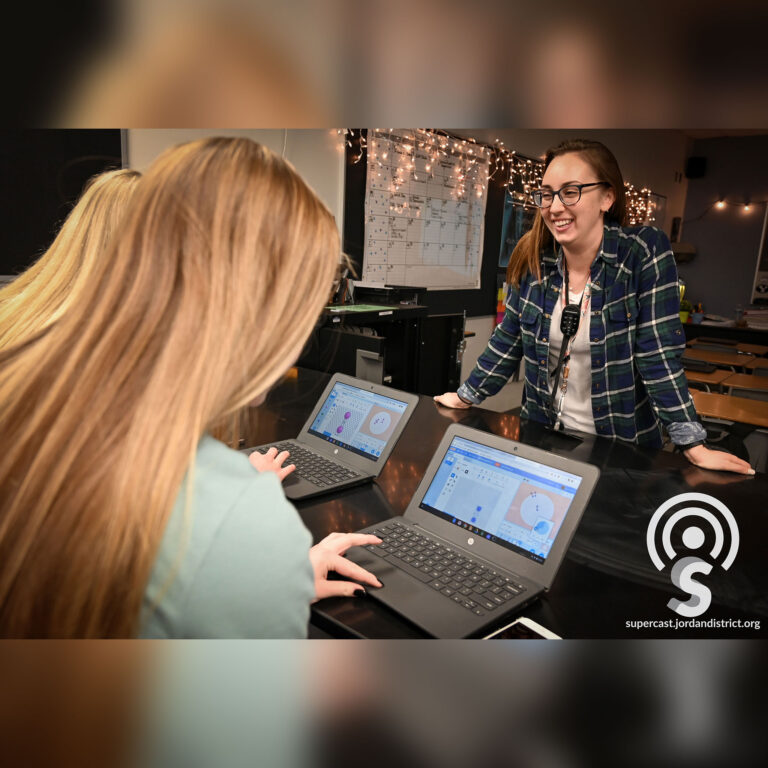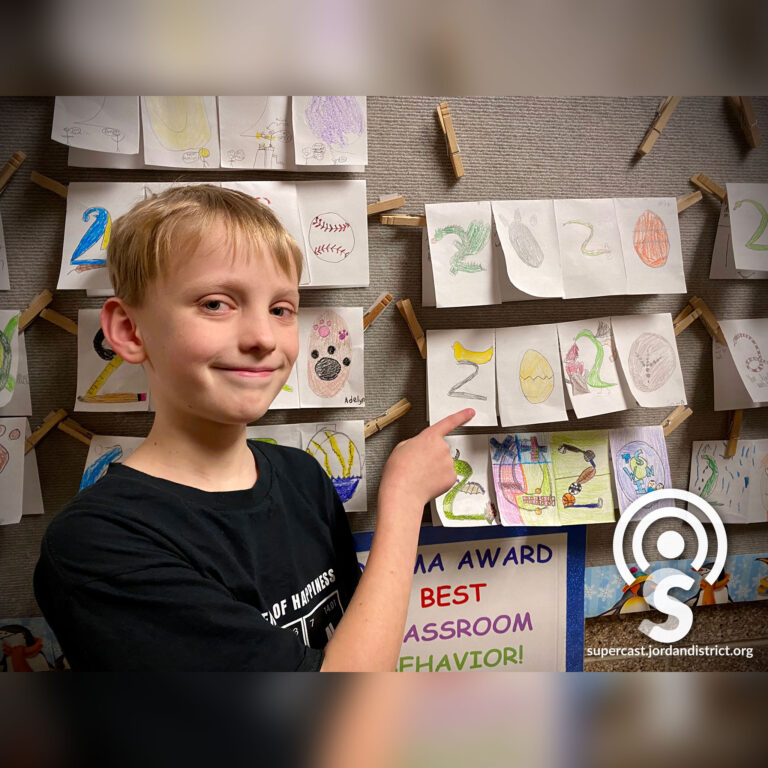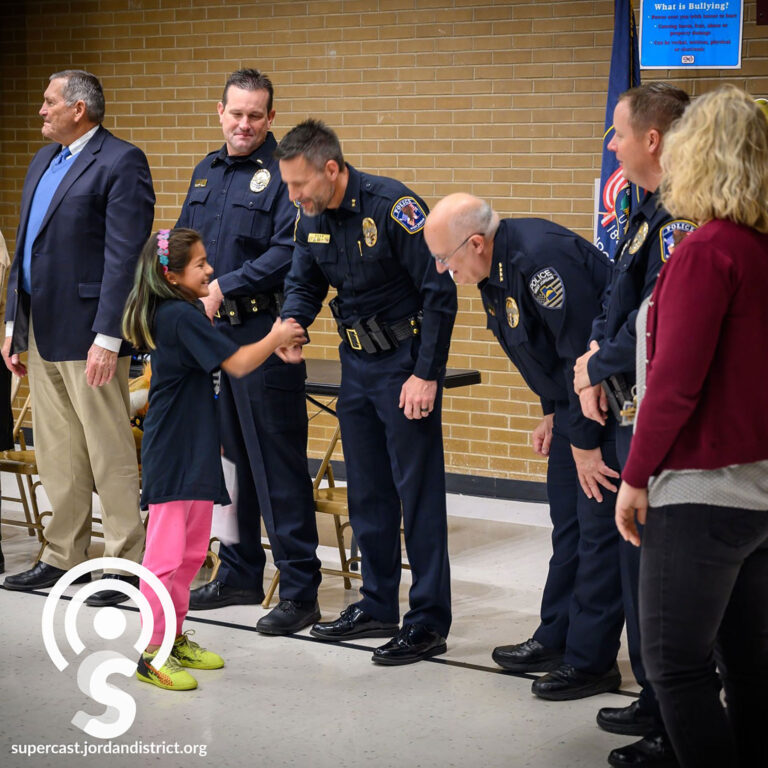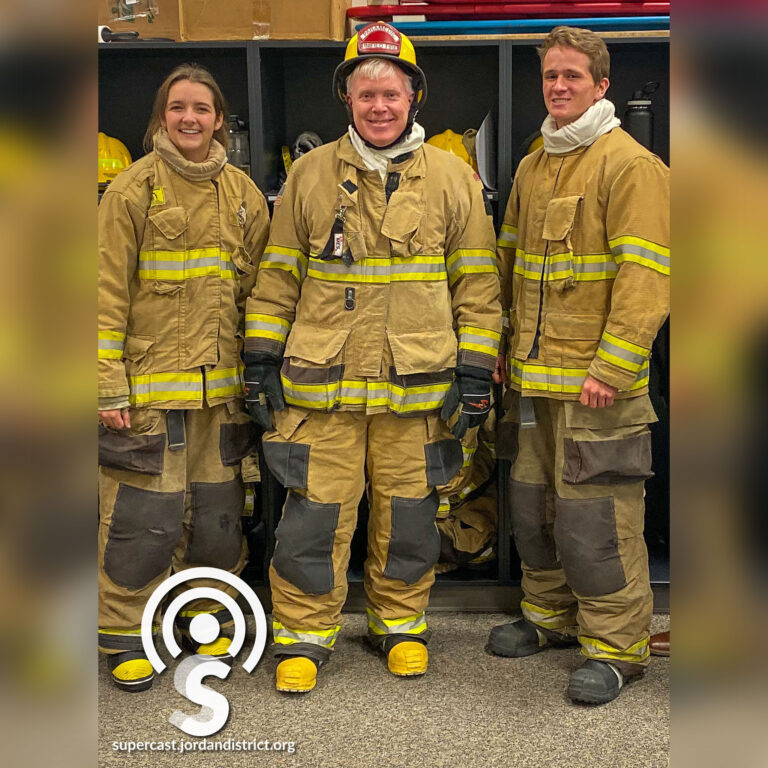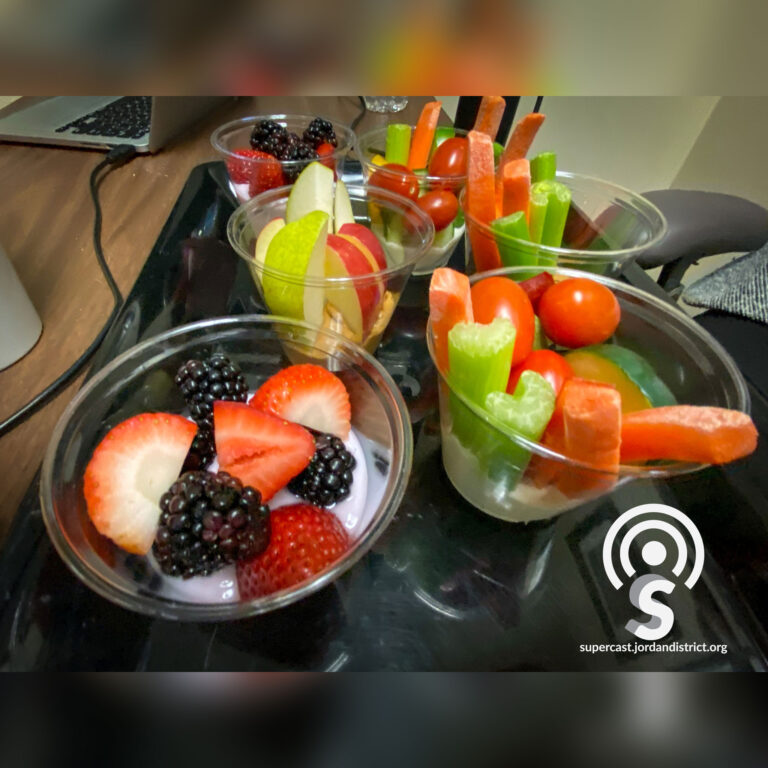Some high school students in Jordan School District will be able to get some more sleep in this coming school year thanks to a first-of-its-kind Late Start Blended Learning Program that will be piloted in all high schools. The Late Start Program will be offered to high school juniors and seniors who will be able to take two on-line courses, which will allow them to start school later - at 9 a.m.
In this episode of the Supercast, we talk about how the new program will work and the benefits to students and teachers.
Audio Transcription
Anthony Godfrey:
Hello and welcome to the Supercast. I'm your host, Superintendent Anthony Godfrey. Today, we're talking about an exciting new program which will allow some high school juniors and seniors to sleep in. If they choose, you can start school at 9:00 AM. We're talking about a first of its kind. Late start blended learning program, which is being piloted in all Jordan School District High Schools in the upcoming school year. Students will have to provide their own transportation for the late start. This is an option, not required, but we are excited about the possibilities. Here to talk about the program and how it will work is Instructional Design Specialist, Michelle Truman. So you've done blended learning for about 20 years. How would you define blended learning? Let's start with that.
Michelle:
The main thing that you have to think of the difference between blended learning and a technology rich classroom. In blended learning, students have some control over the pace of their learning, the place of their learning. So whether that's sitting on a beanbag in a classroom or on their bed at home or at the kitchen table. The path of their learning, there's some choice involved in that as well. So those three are the things that are going to distinguish blended learning from a traditional classroom that's too technology-infused.
Anthony Godfrey:
And that makes a lot of sense because if those three things are flexible for students and for teachers, there's a lot higher chance of engagement.
Michelle:
Absolutely. Who doesn't want choice? Right? Do you want the blue lollipop or the red lollipop? Well, I like red better. Okay. Well, here you go.
Anthony Godfrey:
Everybody wants choice. And this provides choice, not just about where you learn or how fast you learn, but even when you learn. We'll talk more later about what a blended learning model is. But basically it's an online course that still allows students the chance to interact in person with the teacher, as necessary. We're setting up classes like this at each of our high schools. We have a total of 36 teachers teaching 13 different courses that will allow students that level of flexibility that hasn't been available before. We know the health benefits for students, not just physical health but social and emotional wellness that can come from being able to sleep on a rhythm. That makes more sense as a teenager. Even when teenagers try to go to bed early or do go to bed early, they're on a different pattern and they're on a different rhythm. As anyone who's been watching the news knows it's been a hot topic lately, but it's something we've been working on for a while. And I'm really excited to have Michelle here to talk about what the program's going to look like. So Michelle, tell us a little bit about what this program is starting to shape up to be out in our high schools.
Michelle:
They are initially coming in for the late start at 9:00 AM, and that is exactly what's happening. Teachers volunteered at each of the high schools to participate in this. And when I say volunteer, they volunteered to be instrumental in changing education for kids in Jordan School District. What we're going to do is take the traditional curriculum where teachers typically lecture, give assignments, kids go home and practice via homework. What we're doing is creating fully online, interactive, engaging courses that kids can work on at home, at any time they choose, whether it's midnight or 6:00 AM. Then when they need extra assistance or they're going to work with their peers, come in and do a chemistry lab. They can come in to their traditional classroom teacher and work on that with him or her.
Anthony Godfrey:
So will the teacher have office hours where they're available outside of normal class time?
Michelle:
Absolutely. Teachers meet periods one through four on one day and periods five through eight on another day. So when kids come in late start would be first period and fifth period. And so if they need some extra help, they can come to school during that block of time and meet with their classroom teacher. But that's also changed. We have one of our schools. They've had two math teachers pair up so what's happening is the first math teacher's gonna come in the standard time for first period. And he will be in the classroom during that time. The second math teacher is going to come to school two hours late and stay two hours later after school. So if I'm a football player and I want to come in and get extra assistance, I would come during that first period of time. But if I'm another type of student who would rather come in after school, we will have a teacher there to support that as well. So these two teachers are going to share that. They're each going to be responsible for their own classes, but they will share that extra assistance giving on either side of the time schedule.
Anthony Godfrey:
So in other words, it creates greater flexibility for students and for teachers.
Michelle:
Absolutely.
Anthony Godfrey:
So from a student perspective, what this looks like is, rather than signing up for eight classes where I'm going to go to a classroom, I can sign up for two classes, first and fifth period as a blended learning course. And now I don't have anywhere I have to be before nine o'clock. And so I can get some extra rest and set a schedule that more matches my lifestyle as a teenager. Is that correct?
Michelle:
Absolutely. And not only that, it allows for flexibility. So as long as I have an internet connection, I can go to class anywhere.
Anthony Godfrey:
I can think of many reasons that students might want to do this. It might sound like laziness, not starting until nine, but really, there are great health benefits to allowing students to get more sleep in the morning. And there may be health issues that can be addressed by allowing for greater flexibility and in the school day.
Michelle:
Not only that, they will be required to come to school at points during the quarter because if I'm taking a chemistry class, it's great to do an online simulation. But now I've experienced that online simulation, I need to come in and get my hands dirty. I want to play with the beakers and I want to dump solutions and see things that happen. And we need to act like real scientists and that's what real scientists are gonna do. They're gonna study and figure out what they want to do, and what they need to do it.
Anthony Godfrey:
I have to tell you, if I could go back in time to the 1980s, I would have loved this as a high school student, just having this level of flexibility. I'm excited that our kids are going to have that chance coming up this next year. How are the teachers feeling about it?
Michelle:
It's funny. There's been a little bit of reaction across the board. The teachers are involved, they are go-getter teachers and a lot of them are young. And I say, young, in their thirties. So they have their teaching-chops underneath them. But they have a lot of energy and they've grown up and in this environment with technology. And so they don't see it as an adjunct. They don't see it as something in addition to. It's just part of their everyday. It's not anything unique to them and they're really excited about doing this. They look and say, Oh, wow, this is a lot of work. Essentially when you're putting your content online, you are creating not only a textbook, you're creating a digital online interactive book, and now I've got videos I'm creating, and now I'm creating Nearpod slide decks. And I'm creating all this really rich information that's going to go along. And not only that, I can also add an extra helps if I'm in a classroom and I'm teaching. That's the teaching. If kids didn't get it, then somehow we have to come up with something else to help them. Right? But online, what I can do is I can provide the lesson, and then at the end of the lesson, I can say, and if you need some other strategies to help you, here's a video, here's a text, here's some additional readings.
Anthony Godfrey:
How do we look at blended learning versus just online learning? What's that difference?
Michelle:
With online learning, there's typically not that component of face-to-face.
Anthony Godfrey:
What you've described is exactly what I like about blended learning. There is a human component to it and so it's just one more part of the continuum of learning. A traditional classroom on one end of the spectrum and a strictly online class on the other end of the spectrum. And in between you have blended learning that has positive elements of both. What are some of the myths that you encounter when you're working with people who are not used to blended learning or learning online?
Michelle:
It's that technology is going to replace the teacher. Look at all the research. Every piece of research will show that the biggest component of a child's education is the teacher in the classroom. Now, whether that's a virtual classroom, a blended classroom or a face-to-face classroom, it does not matter. It is the teacher that is the most important thing.
Anthony Godfrey:
So technology is still just another way of connecting to that teacher that is essential to effective education.
Michelle:
Absolutely. Kids need to have a connection with a person, whether it is virtual or live. Like I talked about, my adult students still need me to be able to communicate with them, to look at their papers, to give them feedback, to be there for support, same with the students in our classrooms. They can come to you as a face-to-face teacher and say, Hey, I need assistance with this. You can do that virtually online, but how rich is it to be able to take an online class with all the contents there that I can be up when I'm wide awake at midnight, take my class, understand the material. And if I don't the next day, I send an email to my teacher and say, Hey, I'm going to pop into your class at X time, or can you meet me in the lab and be able to arrange for either a one-on-one or a small group assistance.
Anthony Godfrey:
So it's no longer a command performance. It's 7:30 AM, Monday morning time for math. Now, you can match up. You can make that fit into your schedule and everything a lot better.
Michelle:
Say that I'm I'm a football player and we're doing two-a-days because we have this big game coming up. And so I really am not going to have time to do a bunch of work this week. I know that on Saturday, I'm going to sit down and I'm going to do a couple hours worth of coursework. Then I can go take a run, clear my brain, and then I'm going to come back in and do another couple hours. I've now front-loaded all that instruction that I would have had to sit in class and do and get that method of the traditional school model. Now I don't have to. Now I freed up my time because I've completed a week's worth of math on my Saturday when I had the time to do so. And now I can dedicate myself to something I'm passionate about, and that's my sports.
Anthony Godfrey:
We're going to take a quick break. When we come back, we'll head out to Riverton High School, where we talk to teachers about blended learning in Jordan School District.
Break:
The possibilities are endless for anyone looking to grow with a team of professionals, working together to provide the very best for students in education. If you're looking for a great job with great pay and benefits in a supportive environment, head to workatjordan.org and find your future career in Jordan School District. People come for the job and stay for the adventure. Explore the many options. apply today at workatjordan.org.
Anthony Godfrey:
You're at Riverton High School, talking with a couple of teachers who are working on the blended learning project to help allow high school students to have a later start. If they'd like to do, using blended learning is a way to accomplish that. Please introduce yourselves to the folks at home and tell them what you teach.
Teacher:
Hello. I'm Victoria Johnson. I teach biology here at Riverton with my best friend and coworker.
Teacher:
Hi, Bethany Allston. I also teach biology here at Riverton and I'm just happy to be here.
Anthony Godfrey:
What interested the two of you in being part of this, in converting some of your classes to blended learning?
Teacher:
Two years ago, we were looking at ways to assess students better. And Tori said, we got to get on Canvas a little. The following year the State purchased the licenses for all public educators to have Canvas. There's also some really cool features on Canvas for teachers to grade. So you can give some really descriptive feedback pretty quickly, which is a godsend for teachers so we can give students what they need faster.
Anthony Godfrey:
So you told me how you started out with putting classes online and using Canvas and kind of moving toward blended learning. You said that it was because you wanted to give better evaluation of student work. What are some of the other factors that made you want to be teaching in this way?
Teacher:
It's just nicer for kids. We have a lot of kids that don't get it the first time we teach it, especially where we have limited time in the classroom. It's just nice to have those resources there in a concentrated area. So students have the ability to go back through what they're learning. If they did miss something, they have resources available to help them relearn. It's also just nice for communication with feedback. What else?
Teacher:
It's great for differentiating education as well. Certain assignments can be assigned to students who maybe need more help. Those assignments don't have to be assigned to everybody. The students who get those assignments, nobody ever knows that they got the extra work. There's some really great futures for meeting kids where they're at and teaching them, moving forward without ever having anybody else know the better.
Anthony Godfrey:
So the learning is more personalized. It's more flexible. Parents can be more involved. And it sounds like it's easier for teachers, in some ways, once you get it up and running. It's probably a lot of work to get to that point though. Is that true?
Teacher:
A lot of share-ability. It does take some time to load everything in and get it in the order you want, but doing that work upfront makes our job as teachers a lot better. We transfer more into a role of mentoring and assisting students in learning rather than just lecturing all day.
Anthony Godfrey:
If there's a parent or student who isn't sure about whether they want to take a blended learning class next year, what would you you say to them to explain what the advantages might be for them individually?
Teacher:
As far as the advantages go, I would definitely say it's more contoured to what they need so we can meet their needs better at an individual level, personalize the learning. Especially with late start, if they need to do the work at home, but they need to do it later so they can get a little more rest that could benefit them. They benefit.
Teacher:
Yeah. It's helpful for students who have different work schedules. We know a lot of students actually work in the morning or if they work in the afternoon, it just helps them be able to do their learning in their own time. And then we are available still as resources to them. They can come in during a selected amount of time or they can email us or video chat or whatever else is needed. It just is a little bit more autonomous for them where they can kind of pick and choose when they get to do their work, with the exception of assessments and labs which they will have to be in class for. So they'll have their schedule, will have to work in order to be here for those mandatory days.
Some other suggestions that we've made, especially in the course descriptions that we've written, are that if the students plan to take a blended learning course, they need to be prepared to be pretty self monitoring, to make sure they get the work done. Of course, we'll check in with them. And we plan to, for lack of a better word, hover over what they've been able to accomplish to keep them on track. But it's going to require some effort on their part to make sure they're keeping up with the class.
Anthony Godfrey:
I like that you described how parents now aren't just relying on Skyward to look up grades. They can get right into the course. And it's probably the sort of format that allows parents to be more involved in their student's education than ever before.
Teacher:
Yes, which we're really excited about.
Anthony Godfrey:
Thanks to dedicated teachers at Riverton High School for sharing their thoughts on the blended learning. When we come back some final thoughts with Michelle Truman on how your student can get on board.
Break:
Do you want ideas for being happier and healthier? I'm McKinley Withers, Health and Wellness Specialist for Jordan School District. Please join us every week for Wellness Wednesday, a feature on the Jordan District website that offers free and simple tips for improving your health and wellness. We cover a variety of topics to help families with things like reducing stress, improving eating habits, finding more time to build relationships and increasing overall happiness. Check out Wellness Wednesday every week on the Jordan School District http://www.jordandistrict.org For additional health and wellness resources, visit http://wellness.jordandistrict.org.
Anthony Godfrey:
Back with Michelle Truman, talking about the blended learning late start, that will be available at each of our high schools next year. Students who take at least two classes through a blended learning model, which is a combination of online courses and interaction with the teacher, will not be required to be at school before 9:00 AM, but will still be able to access all of the classes they would if they were registered like everyone else. We're excited about this option. How do students access this?
Michelle:
It's going to be different depending upon the high school. All high schools will have it on their website. Some high schools will be having informational meetings in which parents and students will be invited. All high schools will have some sort of communication come home. There'll be a Skylert, and we will also be sending things directly to parents via your children. So be on the lookout for both of those.
Anthony Godfrey:
So to sum it up, I'm really excited about this because students will have the flexibility to start their day at nine o'clock by taking a couple of blended learning courses. Those courses will include very visual and personalized learning that is connected to a teacher at the school they attend the rest of the day. So they have access to the human being behind all this instruction, and in fact, have regular intervals at which they meet with that teacher. And I think that combination can really kickstart a different type of learning for students and provide the type of flexibility that can help them be healthy and happier at school, and just in general. Absolutely lots of exciting things happening. We're going to take another break. When we come back with Michelle Truman, two truths and a lie.
Break:
If you're always looking for opportunities to learn something new, why not join us for the next Jordan Parent University? Jordan Parent University is an opportunity for parents to better understand issues that impact their own students and education. It's an evening class designed to help parents with things like planning for the road beyond high school, better understanding students' social and emotional health and wellness, knowing who to call when there are issues involving a school or a student. Jordan Parent University is free and open to the public. For a list of upcoming classes, times and locations go to http://jpu.jordandistrict.org. See you there.
Anthony Godfrey:
We're back with Michelle Truman. And now it's her time to lie to the Superintendent. It's only been a few months that she's worked in Jordan School District, so this is her chance to lie to the Superintendent on the Supercast.
Michelle:
Okay. I have two children. I was a speed skater when I was in middle school, and my favorite thing to do is go to the beach.
Anthony Godfrey:
A speed skater in middle school. I did not know there was such a thing as middle-school speed skaters, but there must be. I'm going to say you hate the beach.
Michelle:
No, I love the beach. You know what? I think I might've actually said three truths. Did I say three kids or two kids?
Superintendent:
Two kids.
Michelle:
Yeah. It was supposed to be three. I have two kids. All those were true. I set you up for failure.
Anthony Godfrey:
All right. Two truths and a lie, but Michelle cannot tell a lie. Michelle is the George Washington of Jordan School District. Please don't chop down any cherry trees, but we appreciate everything else you're doing here. It's awesome. You're doing great. And I'm excited about all of the energy teachers are bringing to this and more to come. We'll talk more as the program gets put into place next year, to talk about what's happening out there. Thanks again, Michelle, for being on the show and remember whether you're at home at school or anywhere else, education is the most important thing you will do today. We'll see you out there.

